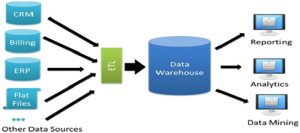What is Data Lake?
A data lake is a central repository build to store, process and secure large quantities of structured, semi-structured and unstructured data. It can store data in its native format and deal with all the variety of it, without any size limitations. A data lake provides an innovative and assured platform which enables companies to integrate data from any system at any speed, even if the data comes from systems on site, in the cloud or edge computing systems.
Data Lake Characteristic
- Data lakes store large quantities of structured, semi structured, and unstructured data. They can hold anything from relationship data to JSON documents to PDFs and audio files.
- The major users of a data lake may differ depending on the structure of the data.
- Information will be available to business analysts when data is better structured. Where data is not structured, data analysis will likely require expertise from developers, data scientists or data engineers.
- The flexible nature of data lakes allows business analysts and data scientists to seek out unanticipated trends and ideas.

What is Data Warehouse?
A data warehouse is a data management system intended to support business intelligence (BI) operations, particularly analysis. Data warehouses are only meant to conduct queries, and analyses and often contain large amounts of historical data. Data from a data warehouse typically come from a wide variety of sources, such as application log files and transaction applications. A data warehouse centralizes and consolidates large amounts of data from multiple sources. Its analytics capabilities enable organizations to extract valuable business information from their data to improve decision-making. Over time, it creates a historical record that can be invaluable to data scientists and operational analysts. A data warehouse centralizes and brings together large amounts of data from several sources. Its analytical capabilities enable organizations to leverage valuable business intelligence from their data to enhance decision-making.
Data Warehouse Characteristics
- Data warehouses retain vast quantities of current and historical data from a variety of sources. They contain a variety of data, from ingested raw data to highly controlled, sanitized, filtered, and aggregated data.
- Extraction, Transformation, and Loading (ETL) processes move data from their original source to the data warehouse.
- Data warehouses are generally equipped with a predefined and fixed relational schema.
- Consequently, they work well with structured data. There are also data warehouses that support semi-structured data.
- Once the data is in the warehouse, business analysts can connect the data warehouses to the business intelligence tools. These tools enable business analysts and data scientists to explore data, seek ideas, and produce reports for operational stakeholders.

Data Lake Vs Data Warehouse
Data lakes and data warehouses are used extensively to store big data, but they are not interchangeably. A data lake is a large raw data set for which the objective has not yet been determined. A data warehouse is a structured and filtered data repository that has already been processed with a specific purpose in mind.
The two types of data storage are often conflated but are much more different than they are identical. The only real similarity between them is their goal of high-level data storage. Differentiation is important because they are used for different purposes and require different sets of eyes for proper optimization.
Differences Between Data Lake And Data Warehouse
- Data lakes mainly store raw data that has not been processed also known as unprocessed data whereas Data warehouse store data that has been processed also known as Processed Data.
- There is no objective individual data in a data leak. Raw data flows in a lake of data, sometimes with a specific future use in mind and sometimes just to have it handy. The processed data are data which have been the subject of a specific use. Given that data warehouses only house the processed data, all data in a data warehouse has been used for specific purposes within the organization.
- Data lakes are often hard to navigate by those who are not familiar with unprocessed data. Unstructured raw data typically requires a dedicated data specialist and tools to understand and translate it for specific commercial purposes.
- Accessibility and usability refer to the use of the data repository, rather than the data it contains.The concept of data warehouses is more structured. One major benefit of data warehouse is data processing and data structure facilitates the deciphering of the data itself, the limitations of the structure make data warehouses difficult and expensive to handle.
